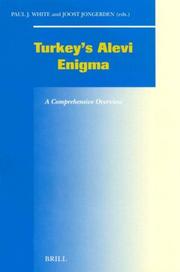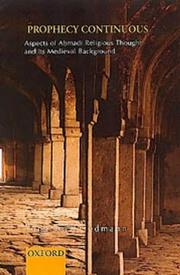| Listing 1 - 10 of 292 | << page >> |
Sort by
|
Book
Year: 1965 Publisher: Paris: Payot,
Abstract | Keywords | Export | Availability | Bookmark
 Loading...
Loading...Choose an application
- Reference Manager
- EndNote
- RefWorks (Direct export to RefWorks)
Book
ISBN: 0879914505 9780879914509 Year: 1978 Publisher: Philadelphia (Pa.): Porcupine Press,
Abstract | Keywords | Export | Availability | Bookmark
 Loading...
Loading...Choose an application
- Reference Manager
- EndNote
- RefWorks (Direct export to RefWorks)
Book
Year: 1930 Publisher: القاهرة: مكتبة القدسي,
Abstract | Keywords | Export | Availability | Bookmark
 Loading...
Loading...Choose an application
- Reference Manager
- EndNote
- RefWorks (Direct export to RefWorks)
Book
ISBN: 9004406719 Year: 2019 Publisher: Leiden; Boston : BRILL,
Abstract | Keywords | Export | Availability | Bookmark
 Loading...
Loading...Choose an application
- Reference Manager
- EndNote
- RefWorks (Direct export to RefWorks)
Muḥammad b. ʿAbd al-Karīm Shahrastānī was born in 479/1086-7 in Shahristān in today's Turkmenistan. After his basic education he went to Nishapur, then a major centre of learning. Afterwards, he taught for some years at the Niẓāmiyya academy in Baghdad. Returning to Khurāsān around 514/1120, he became a staff member at the chancellery of the Saljuq ruler, Sanjar (d. 552/1157), entertaining close relations with him. At some point Shahrastānī returned to his hometown, although it is not known why or when, dying there in 548/1153. His influential history of religions and sects, which also includes an account of Greek and Islamic philosophy, is one of his best known works. Until recently only two Persian translations of it were known: one by Afḍal al-Dīn Turka-yi Iṣfahānī dated 843/1449-50, and an improved edition of it by Muṣṭafā b. Khāliqdād, dated 1021/1612. The anonymous translation published here is much older and may even date from Shahrastānī's own lifetime.
Book
ISBN: 2228132802 9782228132800 Year: 1983 Publisher: Paris : Payot,
Abstract | Keywords | Export | Availability | Bookmark
 Loading...
Loading...Choose an application
- Reference Manager
- EndNote
- RefWorks (Direct export to RefWorks)
Book
ISBN: 9004125523 9004453504 Year: 2002 Publisher: Leiden : Brill,
Abstract | Keywords | Export | Availability | Bookmark
 Loading...
Loading...Choose an application
- Reference Manager
- EndNote
- RefWorks (Direct export to RefWorks)
The Nusayrīs - also known as ʿAlawīs -have been in power in Syria for the past three decades. Little is known of their origins or their long history, while their religious creeds and thought are somewhat better known. The main reason for our fragmentary knowledge of the Nusayrī religion is that, since its beginnings, it has always been the secret faith of a self-conscious elite that zealously guarded its sectarian literature. The Nusayrī-ʿAlawī faith is a clear example of a syncretistic religion. It combines and fuses elements of cults and creeds of very disparate, and remote, origins. Among these are various pagan beliefs (residues of ancient Mesopotamian and Syrian cults), as well as Persian, Christian, Gnostic, and Muslim - both Sunnī and Shīʿī - religious precepts and practices. All these components have been brought together in a syncretistic religious system that has assumed a heterodox Shīʿī garb. The present volume presents a mosaic of fundamental aspects of Nusayrī theology and liturgy. It demonstrates the complexity of Nusayrī theology and the diversity of religious thought within the Nusayrī fold.
Islamic sects. --- Nosairians. --- Islamic sects --- Nosairians --- History.

ISSN: 13853376 ISBN: 9004125388 9004492356 9789004125384 9789004492356 Year: 2003 Volume: 88 Publisher: Leiden; Boston : BRILL
Abstract | Keywords | Export | Availability | Bookmark
 Loading...
Loading...Choose an application
- Reference Manager
- EndNote
- RefWorks (Direct export to RefWorks)
This volume discusses how the multifaceted reality of Turkey's Alevis impinges on society and politics in contemporary Turkey. The book provides readers with a vigorous discussion of the origins and history of the Alevis, examines their ethnic identity and cultural representation, as well as appraising their political life and the effect that this had on Turkey's polity, the Turkish Left and the Kurdish National Movement, and upon the emergence of civil society. It analyses Alevi cultural manifestations and even looks at how Alevi diaspora communities in Europe effect Turkey in various ways. The book therefore provides readers with a convenient handbook of an important group that is largely unknown in the West - Turkey's Alevis.
Book
ISBN: 1108560490 1108623743 1108472508 110866590X Year: 2018 Publisher: Cambridge : Cambridge University Press,
Abstract | Keywords | Export | Availability | Bookmark
 Loading...
Loading...Choose an application
- Reference Manager
- EndNote
- RefWorks (Direct export to RefWorks)
The Ibadi Muslims, a little-known minority community, have lived in North Africa for over a thousand years. Combining an analysis of Arabic manuscripts with digital tools used in network analysis, Paul M. Love, Jr takes readers on a journey across the Maghrib and beyond as he traces the paths of a group of manuscripts and the Ibadi scholars who used them. Ibadi scholars of the Middle Period (eleventh-sixteenth century) wrote a series of collective biographies (prosopographies), which together constructed a cumulative tradition that connected Ibadi Muslims from across time and space, bringing them together into a 'written network'. From the Mzab valley in Algeria to the island of Jerba in Tunisia, from the Jebel Nafusa in Libya to the bustling metropolis of early-modern Cairo, this book shows how people and books worked in tandem to construct and maintain an Ibadi Muslim tradition in the Maghrib.
Ibadites --- Islamic sects --- Kharijites
Book
ISBN: 9781849043014 1849043019 Year: 2014 Publisher: London: Hurst and company,
Abstract | Keywords | Export | Availability | Bookmark
 Loading...
Loading...Choose an application
- Reference Manager
- EndNote
- RefWorks (Direct export to RefWorks)
"Muslim intellectuals may try to define something called British Islam, but the truth is that as the Muslim community of Britain has grown in size and religiosity, so too has the opportunity to found and run mosques which divide along ethnic and sectarian lines. Just as most churches in Britain are affiliated to one of the main Christian denominations, the vast majority of Britain's 1600 mosques are linked to wider sectarian networks: the Deobandi and Tablighi Jamaat movements with their origins in colonial India; the Salafi groups inspired by an austere form of Islam widely practiced in Saudi Arabia; the Islamist movements with links to religious political parties in the Middle East and South Asia; the Sufi movements that tend to emphasise spirituality rather than religious and political militancy; and the diverse Shi'ite sects which range from the orthodox disciples of Grand Ayatollah Sistani in Iraq to the Ismaili followers of the pragmatic and modernising Aga Khan. These affiliations are usually not apparent to outsiders, but inside Britain's Muslim communities sectarian divides are often fiercely guarded by religious leaders. This book, of which no equivalent volume yet exists, is a definitive guide to the ideological differences, organisational structures and international links of the main Islamic groups active in Britain today"--From publisher.
Islam --- Islamic sects --- Muslims

ISBN: 9780195662528 0195662520 Year: 2003 Publisher: New Delhi: Oxford university press,
Abstract | Keywords | Export | Availability | Bookmark
 Loading...
Loading...Choose an application
- Reference Manager
- EndNote
- RefWorks (Direct export to RefWorks)
| Listing 1 - 10 of 292 | << page >> |
Sort by
|

 Search
Search Feedback
Feedback About UniCat
About UniCat  Help
Help News
News